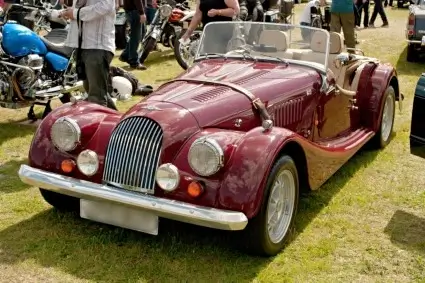Morgan Tyres
Classic Morgan Tyres
On the following pages, Longstone Classic Tyres give classic tyre fitment recommendations for Morgan cars.
If your car is not listed, don't panic! Please give us a call on:
01302 711 123
or
Email: sales@longstonetyres.co.uk
Morgan History
H.F.S. Morgan departed the Great Western Railway in 1904 to co-found a motor sales and maintenance store in Malvern Link. In 1909, he designed and built his own car. He previously invented the first independent front suspension at Malvern College's engineering shop. A year later, he began production, and the company prospered. In 1910, Henry Frederick Stanley Morgan established the Morgan Motor Firm, a family-owned English car company. The early Morgans were modest single-seaters handled with a tiller and driven by either a single cylinder 4 h.p. engine or an 8 h.p. V-twin engine built by the London business J.A. Prestwich.

The next year, a two-seat 'Runabout' with a steering wheel and even a hood was produced, and it was a major commercial success. Morgans had set 10 British and Records for different classes of cyclecars in the years running up to the commencement of war in 1914, won 24 Gold Medals in important reliability testing, and won several racing victories. Morgan was one of the first car producers to begin full production when peace was restored in 1918, owing to the simplicity of the construction.
In 1920, another unique Morgan was created, inspired by Capt. Albert Ball's specially bodied Grand Prix automobile. In honour of the great aviator, this was dubbed the Aero. H.F.S. Morgan's first designs were so sophisticated that only minor bodywork changes were required for several years. The car's durable, lightweight structure was kept, and the two-speed gearbox system was produced until the 1930s.
Throughout the 1920s, the Morgan sustained its success in racing, it was so quick that it had to start a lap behind four-wheeled vehicles in the same class at Brooklands. Racing results prompted the creation of another racing variant, the Super Aero, with a reduced streamlined exterior, in 1927. Following the success of the previous vehicles, the Super Aero was soon in action on the trials hills and on the racecourse. Not only were the vehicles dominating in motorsport, but they were also one of the most glamorous automobiles to be seen driving on the open road.
Morgan had a banner year in 1933, pulling in a slew of World Records with its train. In 1933, a new model known as the F-type with a Ford engine was introduced. The prototype was photographed in the factory's backroom. A four-wheeler was presented at the London and Paris Exhibitions in 1936 after a prototype had been assessed in trials and on the track. To distinguish it from the three-wheeler, the new model was dubbed the Morgan 4-4, which denotes the four wheels and four cylinders.
During the Second World War, car manufacture ceased altogether, and the Company kept just two departments for repairs. The Standard Motor Company Aero Engines division occupied Rows 3, 4, and 5, and the plant produced a range of components for the war effort, including carburettors, aircraft undercarriage, and other precise technical work. The Standard Motor Company announced their 'One Engine Policy' in 1947, which meant that the 1267 c.c. unit would no longer be available to Morgan after 1949.

The Morgan 4/4 was revived as the Series Two in 1955. This was an automobile with a similar design to the Plus Four but with a smaller 10 horsepower Ford side-valve engine and integrated gearbox, with the goal of providing a sports car with dynamic performance and appearance for the hobbyist with limited funds. The TR 3 engine was installed in the Plus Four in 1956, raising the power to 100 horsepower, which was particularly fast when constructed with lightweight aluminium bodywork. Plus Fours won several production sports car races in the United States of America. Lew Spencer was a common sight on the winner's podium, and his Morgans, all of which had the moniker 'Baby Doll,' developed a sizable fan base.
The Triumph TR engine was reaching the end of its useful life in 1966, and a suitable successor was sought. The Rover Motor Company announced the availability of the next aluminium Rover V8 engine. Mr Maurice Owen joined the company to oversee the creation of the new automobile, the Morgan Plus Eight, which was unveiled to the world at the Earls Court Motor Show in 1968. Morgan's reputation on the racetrack was maintained by the Plus 8. This was one of the company's most popular vehicles, and manufacturing lasted for 36 years until the car was retired in 2004.



